Why Restarting Medication After a Break Is Dangerous
It sounds simple: you stop taking your medicine for a while-maybe because you felt better, had a hospital stay, or took a break from treatment-and then you start again. But here’s the hidden risk: your body forgets how to handle the same dose. That dose that used to feel normal? Now it could be deadly.
This isn’t just a theory. It’s a leading cause of overdose deaths, especially with opioids, benzodiazepines, and certain antidepressants. People who’ve been off their meds for even a few days often go back to their old dose-and end up in the hospital, or worse. The body’s tolerance drops fast. For some drugs like methadone, tolerance can vanish in just 3 to 5 days. That means your system no longer has the same defense against the drug’s effects. Breathing slows. Consciousness fades. And if no one’s around, it can turn fatal.
Who’s at the Highest Risk?
You’re at higher risk if you’ve recently been released from jail, left a rehab center, or been discharged from a hospital after treatment. These are moments when people often stop taking their meds-and then restart them without medical help. In Washington State, 62% of fatal opioid overdoses happen within 72 hours after someone leaves a correctional facility or treatment program. That’s not a coincidence. It’s a pattern.
It also happens with people who’ve been sober for months or years. Take Philip Seymour Hoffman’s case-he hadn’t used opioids for over 20 years, but when he relapsed, he took the same dose he used to. His body couldn’t handle it. He wasn’t reckless. He just didn’t know his tolerance was gone.
Even people on antidepressants like paroxetine or venlafaxine aren’t safe. Restarting too soon after stopping can cause serotonin syndrome, a life-threatening reaction. And mixing opioids with alcohol, sleeping pills, or benzodiazepines? That’s a recipe for respiratory failure.
What Happens to Your Body When You Stop?
Your body adapts. When you take a medication regularly, your brain and organs adjust to keep things balanced. That’s tolerance. But when you stop, those adaptations don’t stick around. Your liver stops producing extra enzymes to break down the drug. Your receptors become more sensitive. Your breathing control centers reawaken to normal function.
For opioids, this means your body no longer suppresses your breathing as much as it used to. So when you take the same dose again, your brain doesn’t get the signal to keep breathing. That’s how overdose happens-not because you took too much on purpose, but because your body forgot how to cope.
For benzodiazepines, tolerance loss happens fast. Restarting at your old dose can cause extreme drowsiness, confusion, or even coma. With antidepressants, restarting too quickly can trigger serotonin toxicity-symptoms like high fever, rapid heart rate, muscle stiffness, and seizures.
The Safe Way to Restart: Start Low, Go Slow
The only reliable way to avoid overdose is to restart at a fraction of your old dose-and increase it slowly under medical supervision. Here’s what that looks like in practice:
- Opioids: Begin at 25% to 50% of your previous daily dose. For example, if you were taking 60 mg of oxycodone daily, start with 15-30 mg. Monitor for drowsiness, slow breathing, or pinpoint pupils. Wait at least 24 hours before increasing.
- Methadone: Start at 10-20 mg per day, even if you used to take 80 mg or more. Tolerance drops quickly. Going too high too fast has killed people.
- Benzodiazepines: Begin at 25% of your previous dose. Increase by no more than 25% every 3-5 days. Watch for confusion, dizziness, or trouble walking.
- Antidepressants (SSRIs, SNRIs): Wait at least 2 weeks after stopping before restarting. For MAOIs, you must wait 14 days before starting any other serotonergic drug. Restart at 25% of your old dose and increase gradually.
- Quetiapine (Seroquel): Start at 25 mg per day-even if you used to take 300 mg. Postural hypotension (dangerous drops in blood pressure) is common if you restart too fast.
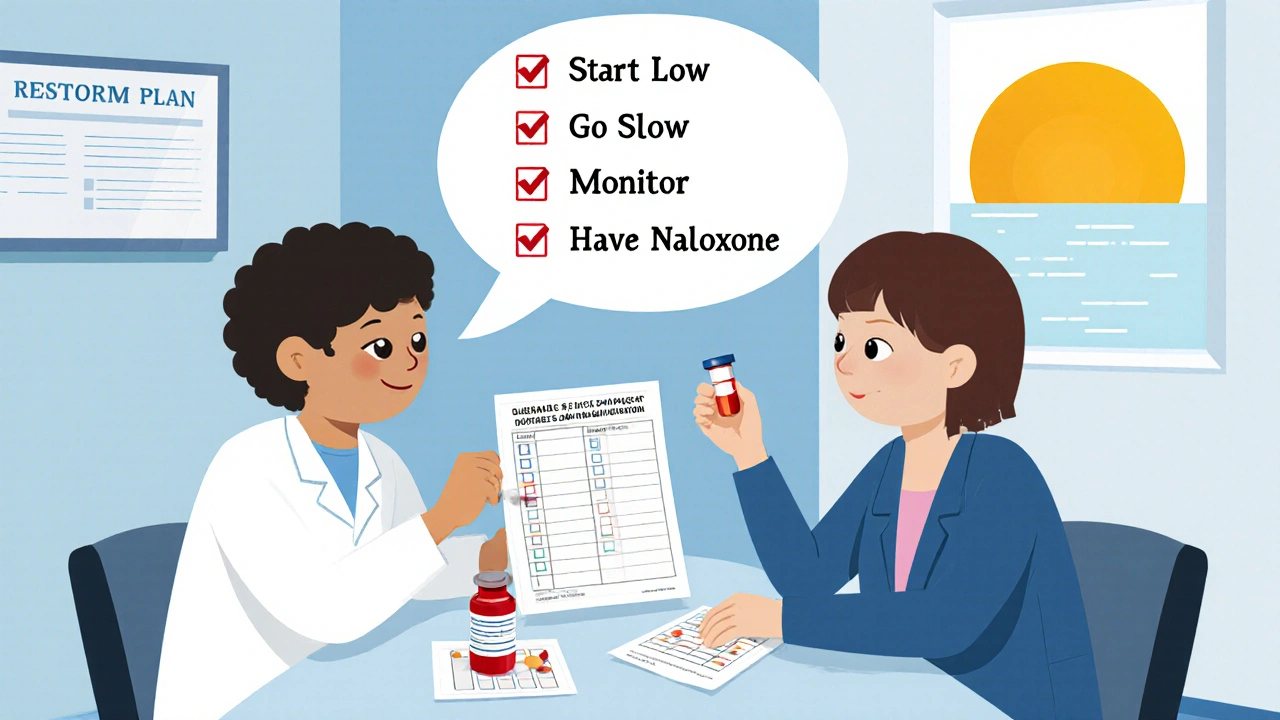
What to Monitor During Restart
Don’t just take the pill and walk away. Watch for these warning signs:
- Respiratory rate below 12 breaths per minute-this is a red flag for opioid overdose.
- Pinpoint pupils-a classic sign of opioid effect.
- Extreme drowsiness or inability to wake up-even if you think they’re just tired.
- Confusion, rapid heartbeat, muscle rigidity-possible serotonin syndrome.
- Dizziness or fainting when standing up-could mean low blood pressure from restarting certain meds.
If you notice any of these, stop the medication and get help immediately. Don’t wait. Don’t assume it’ll pass. Overdose doesn’t always come with screaming or drama. Sometimes, it’s just silence.
Naloxone Is Not Optional
If you’re restarting an opioid, naloxone (Narcan) should be in your home, your car, and your pocket. It’s the only thing that can reverse an opioid overdose. And it’s not just for addicts-it’s for anyone restarting after a break.
Keep it with someone you trust. Teach them how to use it. Naloxone works fast. It’s safe. It won’t hurt you if you don’t need it. But if you do need it? It could save your life. Washington State and the CDC both say: if you’re restarting opioids, you should have naloxone before you even take the first pill.
When to Skip Restarting Altogether
Not every medication needs to be restarted. Ask yourself: Do I still need this drug? Is the reason I stopped still true? For example, if you stopped an opioid because your pain improved, maybe you don’t need to go back. If you stopped an antidepressant because you felt better, maybe therapy or lifestyle changes can replace it.
Some medications have safer alternatives. If you were on a high-dose benzodiazepine for anxiety, maybe a non-addictive option like buspirone or CBT could work now. Talk to your doctor. Don’t assume you need to go back to what you used to take.
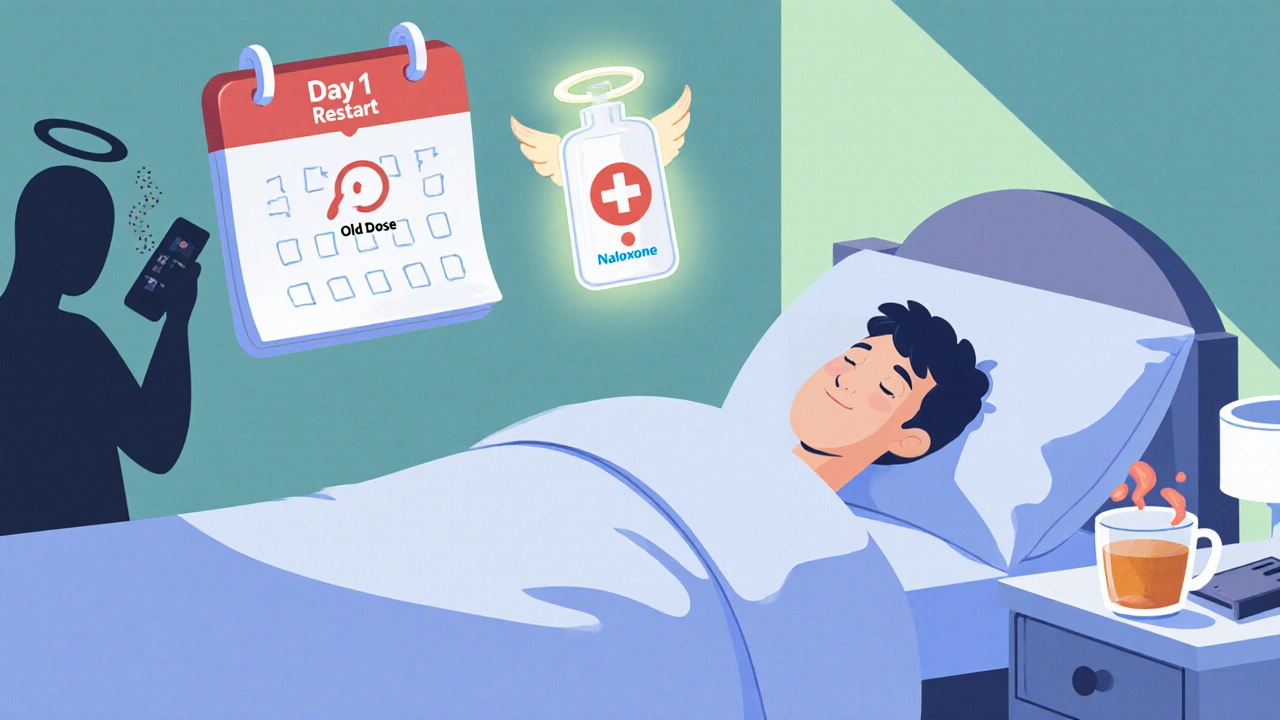
Why Medical Supervision Matters
Restarting alone is risky. Doing it with a doctor or pharmacist reduces overdose risk by more than 40%, according to internal data from Evoke Wellness. Clinics that follow structured restart protocols have an 87% success rate. Those without? Only 42% make it through without incident.
Doctors can check for drug interactions. They can adjust for liver or kidney function. They can coordinate with your mental health provider. They can set up follow-up calls or telehealth check-ins. You don’t have to do this alone.
What’s New in 2025
There’s progress. The FDA released draft guidelines in May 2023 standardizing restart protocols for opioid therapy. In February 2024, the American Society of Addiction Medicine introduced a 10-point scoring system to calculate safe starting doses based on your abstinence length, past dose, and health conditions.
Research from Johns Hopkins shows that taking extended-release naltrexone (Vivitrol) before restarting opioids cuts overdose risk by 73% in the first 30 days. It blocks opioid receptors, giving your body time to re-adjust safely.
Wearable devices that detect low breathing and auto-administer naloxone are in late-stage trials. These could be game-changers for people living alone.
Final Advice: Don’t Guess. Get Help.
You didn’t become addicted because you were careless. You didn’t stop because you didn’t care. You’re trying to take care of yourself. That’s why restarting safely matters.
Don’t rely on memory. Don’t trust old habits. Don’t assume your body remembers how to handle the same dose. Your tolerance is gone. Your risk is real.
Call your doctor. Ask for a restart plan. Bring your old prescription records. Tell them you’re worried about overdose. They’ve seen this before. They know what to do.
And if you’re helping someone else restart? Be the person who says, "Let’s get you checked out first." Be the one who keeps naloxone handy. Be the one who doesn’t let pride or fear stop you from asking for help.
How long does it take to lose tolerance to opioids after stopping?
Tolerance to opioids can drop significantly within 3 to 5 days after stopping, especially for short-acting drugs like heroin or oxycodone. For longer-acting opioids like methadone, tolerance may take 7 to 10 days to fully decline. Even after just one week off, your body may no longer handle your previous dose safely.
Can I restart my medication at my old dose if I feel fine?
No. Feeling fine doesn’t mean your body is ready. Tolerance is invisible. You may feel normal, but your breathing control, liver metabolism, and brain receptors are still adjusting. Restarting at your old dose can cause respiratory depression, coma, or death-even if you’ve taken it safely before.
Is it safe to restart antidepressants after stopping for a few weeks?
It depends on the drug. For SSRIs and SNRIs like sertraline or venlafaxine, restarting after 2 weeks is usually safe if done slowly. But if you were on an MAOI, you must wait at least 14 days before starting any other antidepressant. Restarting too soon can cause serotonin syndrome, a dangerous condition with high fever, confusion, and muscle rigidity.
What should I do if I accidentally take my old dose?
If you took a full dose of an opioid or benzodiazepine after a break and feel drowsy, dizzy, or have trouble breathing, call emergency services immediately. If you have naloxone, use it right away-even if you’re not sure it’s an overdose. Stay with the person until help arrives. Do not wait to see if they "wake up on their own."
Can I use naloxone more than once if needed?
Yes. Naloxone wears off in 30 to 90 minutes, but opioids can stay in your system much longer. If symptoms return, you can give another dose. Many people keep two doses on hand for this reason. Naloxone is safe to use repeatedly and won’t harm someone who doesn’t need it.
Does insurance cover supervised medication restart programs?
Yes. Since the 2020 Overdose Prevention Act, 87% of commercial insurers in the U.S. cover supervised restart programs. Medicare covers 100% of naloxone costs and often pays for outpatient monitoring. If you’re unsure, call your insurer and ask if they cover "medication restart with clinical oversight."

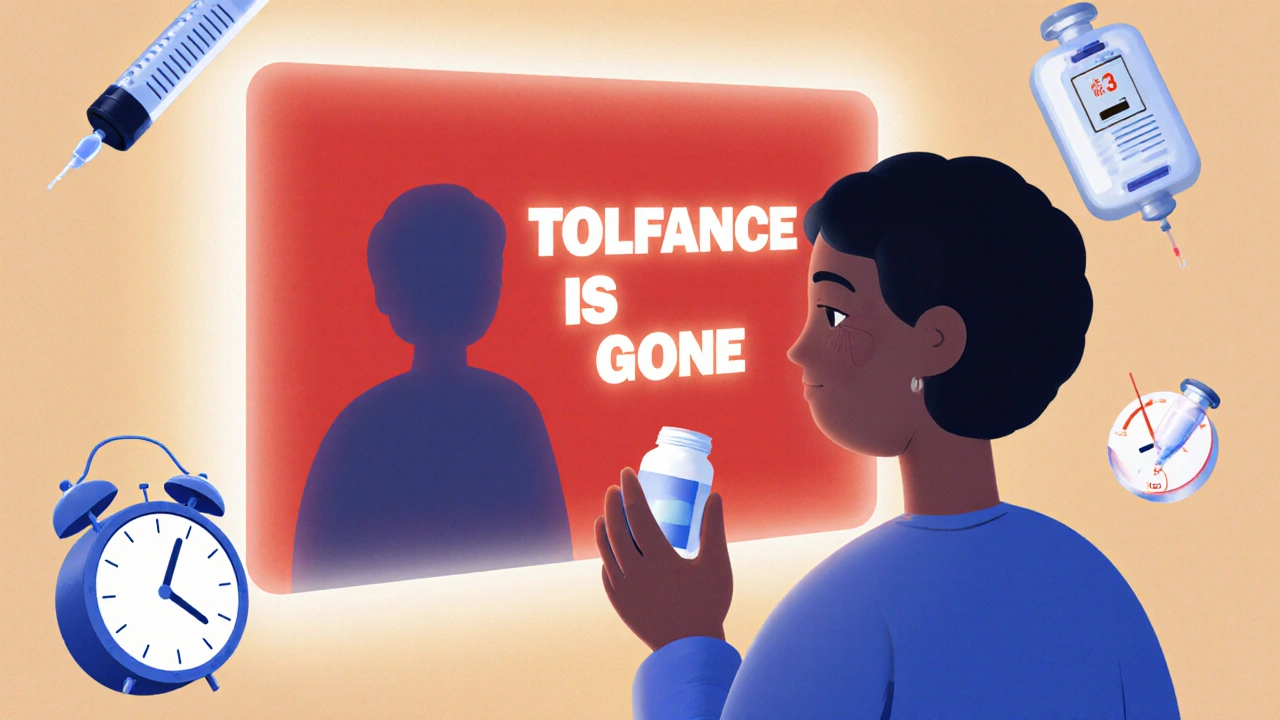
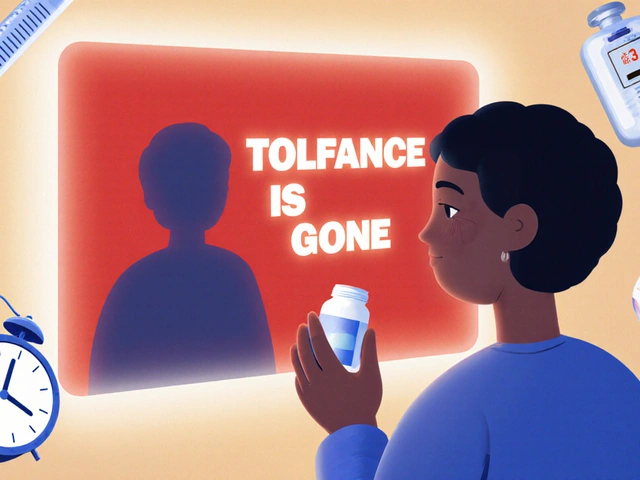

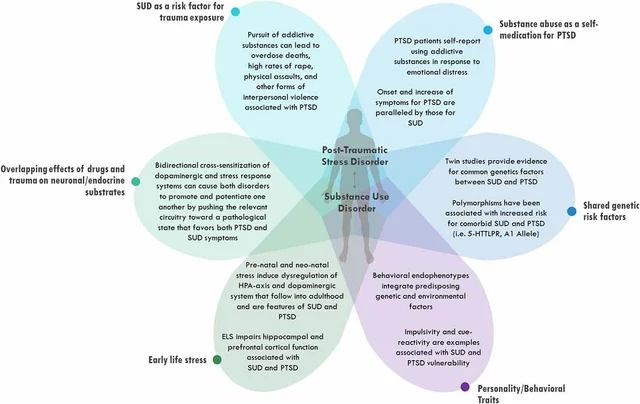


Comments(10)